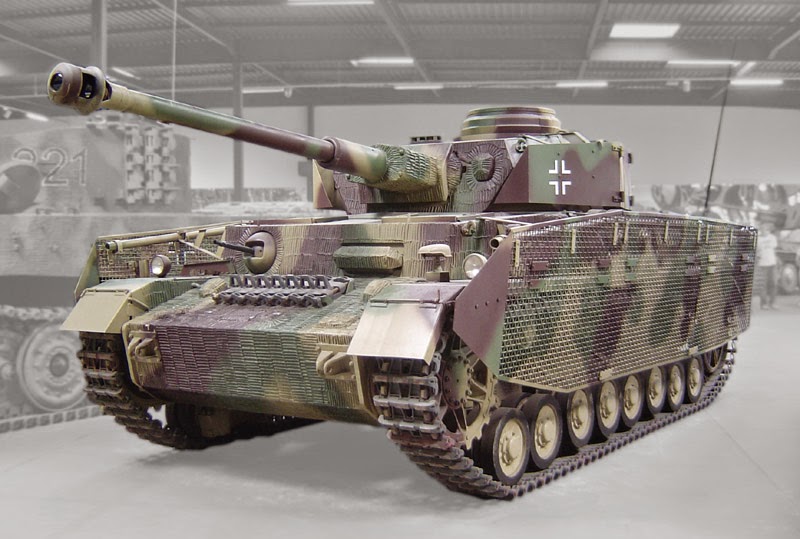The Panzer IV would remain in production throughout the war.
The most numerous and the most versatile tank the Wehrmacht developed, it is
also usually considered one of the world’s classic armored vehicles, a strong
contender for Top Ten status in any comparative listing. Its origins were
unpretentious. The Weapons Office wanted armaments firms to gain experience
designing and producing heavy tanks. Lutz and Guderian had from early days seen
the need for a support tank. The result was a project for a “battalion
commander’s vehicle” of 24 tons—the bridge weight limit—mounting a 75mm gun,
which was really a howitzer, only 24 calibers long. Dubbed by its crews as the
“cigar butt” and other, cruder names involving length, its high-explosive and
smoke shells were intended to provide for close support—not only for tanks but
for their accompanying infantry. In the war’s early years, however, a
three-inch shell exploding on or near a tank could do significant damage—not
least to crew morale. The Panzer IV would acquire from its early days an
enduring reputation as a formidable opponent.
The Panzer IV suffered from an embryonic armament industry’s
lack of experience producing even moderately large tanks, and from an
increasingly overstrained manufacturing capacity. Only about 200 were on
inventory by September 1, 1939. That was enough, however, to begin allocating a
company to each battalion, and to test the three-to-one combination initially
proposed by Lutz and Guderian. The design withstood prototype testing
admirably. The Panzer IV’s suspension matched its eventual 20-ton weight, and
was so reliable it became standard for all the later versions. Its
superstructure was proportioned generously enough to allow for up-gunning. Its
turret was electrically powered, improving exponentially the chances of getting
off the first shot so often decisive in mobile war. Add standard frontal armor
of up to 50mm, with 20mm on the sides and rear, plus a reliable Maybach engine
giving a top speed of 20 miles per hour and a 100-mile range, and the Panzer IV
was a crew’s delight when it began entering unit service in 1938.
The two-year seesaw conflict across North Africa has been so
often described in so much detail that it is easy to exaggerate its actual
impact on Hitler’s panzers. The campaign involved only three mobile divisions
and never more than around 300 tanks at any one time. Technically the Germans
maintained a consistent, though not overwhelming, superiority—reflecting as
much the flaws in British tank design as the qualities of the German vehicles.
The Panzer III, especially the L version with the 50mm/62-caliber gun, was the
backbone of Rommel’s armor, admirably complemented by the Panzer IV, whose 75mm
shells were highly effective against both unarmored “soft-skinned” vehicles and
unsupported infantry, even when dug in.
The Sherman’s mid-velocity 75mm gun, able to fire both armor
piercing and high-explosive rounds, made it the best tank in North
Africa—except possibly for the later marks of Panzer IV, who brought their even
higher velocity 75mm gun on line in numbers too small—never more than three
dozen—to make a difference.
Replacing the panzers’ material losses was not a simple
one-for-one process. The workhorse Panzer III was increasingly outclassed by
its Soviet opponents—less from any qualitative improvement than because the
Russians were beginning to learn how best to take tactical advantage in
particular of the T-34’s powerful gun and high maneuverability. The Panzer
III’s chassis was too light, its turret ring too small, to be a useful
transition to the next panzer generation. They were issued as stopgaps, and by
mid-1943 appeared in no more than company strength.
The Panzer IV, in contrast, had a future. Improved muzzle
braking enabled it to carry the 43-caliber Tank Gun KwK 40, and a more powerful
48-caliber version introduced in late 1942. More than 1,700 of these F and G
models were produced or upgraded before they gave way in March 1943 to the
definitive late-war Panzer IVH. Its armor was significantly increased: 80mm on
the front and 50mm on the turret, 30mm on the sides and 20mm in the rear—the
latter reflecting Red Army infantrymen and antitank crews’ willingness to come
to close quarters for a kill. The additional protection increased weight to 25
tons and reduced speed to 21 miles per hour, but the Model H could still move
and maneuver well enough. Its 75mm, 48-caliber gun was roughly equivalent to
the T-34’s main armament, and effective against almost anything it could reach.
The Panzer IVH/J integrated a useful set of upgrades into a
state-of-the-art light medium tank, intended to equip one battalion in each
panzer division. More than 3,000 would be built in 1943, and more than 3,100 in
the war’s final 18 months. They were nevertheless regarded as stopgaps, holding
the line for a new generation of exponentially more powerful armored fighting
vehicles.





